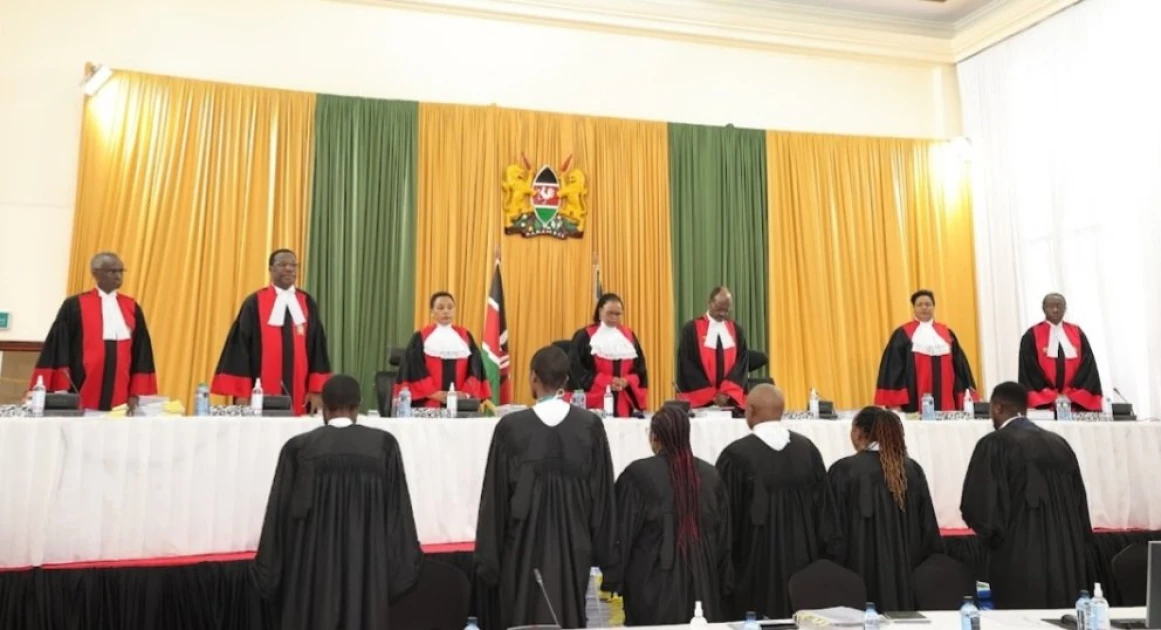7 major questions Supreme Court judges want presidential election petitioners to answer

Supreme Court judges during the hearing of the 2022 presidential election petition. PHOTO| Judiciary

Audio By Vocalize
Petitioners
challenging the outcome of the 2022 presidential election on Wednesday made
their presentations in court where they sought to convince the highest court in
the land to nullify the August 9th polls.
The legal
teams for the petitioners in the case raised various claims among them interference
with the election system and divisions within the commission, seeking to prove that
the election did not meet the constitutional threshold of being free, fair and
transparent.
After the
day-long submissions, the Supreme Court judges raised various questions seeking
to understand some of the arguments raised by the petitioners.
Forms
34A
Key among
the queries raised by the seven-judge bench led by Chief Justice Martha Koome was
how forms 34A, whose content is manually filled in, were being intercepted within the
IEBC servers, doctored and then re-uploaded onto the servers.
“I have
been intrigued… we have this form 34A… for ease of understanding, let us say it
leaves the polling station by road to go to the national tallying centre. Its image
leaves to go to the same destination, but this time by air.
Somewhere, in midair,
the image is captured and all sorts of things are done before it is re-uploaded.
This means if you go to that re-uploaded image you will see different content
from what it had at the polling station. To determine whether that has actually
taken place. You would have to go back to the tallying centre and locate the
one that left by road and compare. Is it possible that that capturing midair
somehow magically changes the content of the one that left by road?” posed judge
Smokin Wanjala.
On the same
issue of forms 34A, Justice Njoki Ndung’u posed: “I don’t understand much about
ICT but I presume that at the polling station when the KIEMS kit takes the
image, these forms are written in handwriting. How can a form be changed in handwriting….
How does that happen?”
Deputy Chief
Justice Philomena Mwilu asked a related
question on the same, urging to know in what form was Forms 34A being
uploaded onto the IEBC servers.
“When the form
34A is captured using the KIEMs kit at the polling station, is it an image, a
photo or what is it called? That time when it is taken and as it is being sent originally,
is it in pdf form? The journey from polling station to Bomas, the things that
happen in between, must be described by the nature of that image at the
starting point,” she submitted.
IEBC Divisions
The Apex
court judges also sought to know the genesis of the infighting within the electoral
commission, which some of the petitioners have cited as grounds for the indictment
of the chairperson Wafula Chebukati.
“We saw the
commissioners in public reading out the results. They did this until the 11th
hour. What evidence do we have that this is not an afterthought? Do we have
anything showing that for the last three or four months they documented these
grievances and that there was therefore a storm brewing,” posed Justice Isaac
Lenaola.
“When did
this commission become so dysfunctional? What was the effect of becoming that
dysfunctional? What corrective measures were attempted and with what result.?” DCJ
Philomena Mwilu.
Justice Smokin
Wanjala wondered why the commissioners never spoke out earlier on the intrigues
at the commission. He further wondered how powerful Chebukati is to intimidate
the commissioners.
“We have
been informed that the commissioners were allocated roles other than those for
which they were appointed. Why didn’t they protest? Is this chairperson we are
dealing with such a terror that no one can deal with. Why did these serious Kenyans not seize that chance and protest to the people of Kenya?" He posed.
Chebukati’s
Fate
The judges
also sought more indulgence on some of the reliefs sought by the petitioners
among them a declaration that IEBC Chairman Wafula Chebukati was culpable of
electoral malpractice and should thus be found unfit to oversee elections as well
as unfit to hold office.
“You have
asked this court to find the chairman culpable of various breaches and even if
there should be a repeat election, he cannot preside… My dilemma is, this is a
constitutional office holder. Under Article 251(2) there is a detailed
procedure for the removal of a constitutional office holder. How do we go about
that? Would we be making an order contrary to the constitution?” Chief Justice
Martha Koome asked the petitioners.
Justice
Ibrahim also addressed the implications of declaring Chebukati unfit to hold office
in view of the legal gap that would result should there be an order for
a fresh election.
“If an
election is ordered to be done, yet one of the reliefs you are seeking is that
the chair be declared unfit to hold office… our constitution has never contemplated
such a lacuna. How is that possible? What are your proposals practically on the
ground?" he posed
Nullification
of results
Justice Mohamed
Ibrahim also questioned the legal basis of the relief sought by the petitioners
who are asking for a nullification of the recounts, a recount of votes and declaration
of Azimio leader Raila Odinga and his running mate Martha Karua as winners of
the August 9th presidential poll.
“We would like you to lay a legal basis for this in your rejoinder. No remedy or relief that has been sought will be taken casually… Is this doable, feasible in law and in all other practical ways?” posed Justice Ibrahim.
"In the event we arrive at figures showing either the current president elect has more votes or the petitioner in petition number 5 (Raila) has more numbers, what are we to do… as we still to declare irrespective of all other processes?" she posed.
Kakamega,
Mombasa Elections postponement
The Supreme
Court also sought to understand from the petitioners on how, the
postponement of Governor elections in Kakamega and Mombasa Counties affected
the outcome of the presidential polls yet elections for all the elective seats
are separately provided for in the law.
“You said the postponement
of election in certain areas resulted in voter suppression… people wake up one
morning to vote for a specific category of voters. E.g MCA, Senator but not the
other positions?” questioned Justice William Ouko. “Do we have any scientific nexus to this or
is it just an assumption that this happens?”
Justice
Njoki Ndung’u on her part asked: “If we look at the Constitution, each of these
elections are separately provided for in terms of qualifications, nomination process
even dispute resolution. A voter gets 6 ballots and drops them into six ballot
boxes.”
“Is
voter repression only on presidential election or is that an argument that can
be used by an MCA in Kakamega County to say that because the governor elections
were not held on that day, their votes were also affected,” she asked.
Violence
at Bomas
Justice Lenaola
asked the commissioners to explain further what impact the violence witnessed
at Bomas National Tallying centre had on the elections.
"What
role did violence play at Bomas? We have the evidence of the chairman that he
could do this or that because he was attacked…You need to explain that as the
commission,” he said.
“What is the relevance of the percentage of voter turn out to determining whether a candidate marshalled the magic number,” Justice Wanjala posed to the petitioners.


Leave a Comment